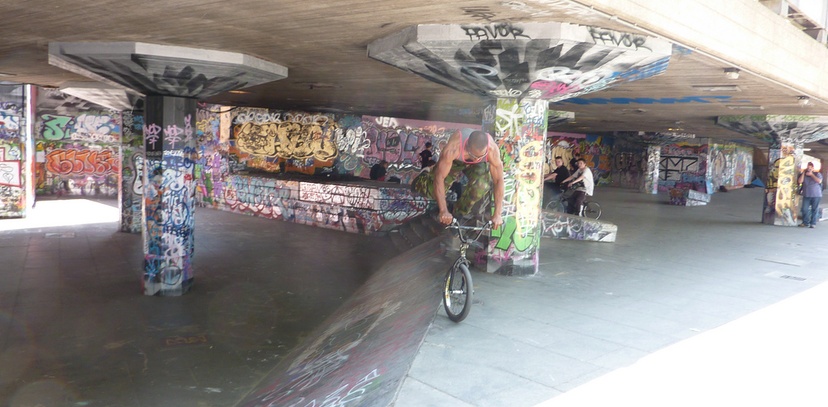
There is no physical sign indicating to the passer-by that the colourful concrete space hidden under the Royal Festival Hall is a skate park. It only becomes evident as soon as you see the skateboarders rushing around doing their runs.
This skate park is normally invisible. It only exists when something is being performed. It is through their cultural practice that they've given this undefined space meaning. Like the actors above them in the National Theatre, the skaters carve out their terrain through their movements and relations with others and as soon as they leave this symbolic space disappears, only to be formed in a new way the following day.
Professor Iain Borden from the Bartlett School says, "Skateboarding leaves almost no text to be read; its marks and assaults leave virtually no discernible script for others to translate and comprehend" (2003: 295). Unlike the theatre above, spaces like this skate park cannot be represented with maps or signs. They are informal, intangible landscapes whose identity is constructed through the everyday collective memory of the performers and their spectators.
Now there is the real possibility that this fragile urban landscape will disappear. Unfortunately, by helping to create the image of the Southbank as an exciting, informal, creative performance space, the skaters have also raised the market value of this land and sown the seeds of their own destruction. The current proposals for the upgrading of the Southbank Centre are for the Undercroft to be replaced with non-descript shops disguised in temporary/informal/creative-looking containers. Among other chains masquerading as creative places, there will probably be a Waterstones. It will probably sell expensive art books and postcards of cool places in London. No doubt there will be a few postcards of the old skate park on sale.
But this isn't just about the skate park, this is about the skaters: a group of citizens choosing to express themselves through the use (not the ownership) of public space, and sharing that experience with others. I'm an aspiring urbanist by profession and a Londoner by birth and I strongly believe that removing the skaters from the Undercroft in the Southbank will not only take the heart out of the Southbank, but it will also take the heart out of London.
What message does one of the world's most important centres for creativity send if it replaces this symbol of public expression with a few money-making shops? Ideally in a democracy, cities should be the stage on which the diverse identities of citizens can be expressed and imagined in informal, intangible ways. This is something priceless. Isn't it?
In response to pressure from the public, the National Theatre and English Heritage, today the Southbank Centre requested time to review their plans submitted to Lambeth Council for the £120m revamp of this site.
Reference: Borden, I. (2003) ‘A Performative Critique of the City: The Urban Practice of Skateboarding’, in [eds.] Malcom Miles, Tim Hall, Iain Borden, The City Cultures Reader, Oxon: Routledge, 291-297.
This post was written by Lucia Caistor Arendar, Associate at Social Life.